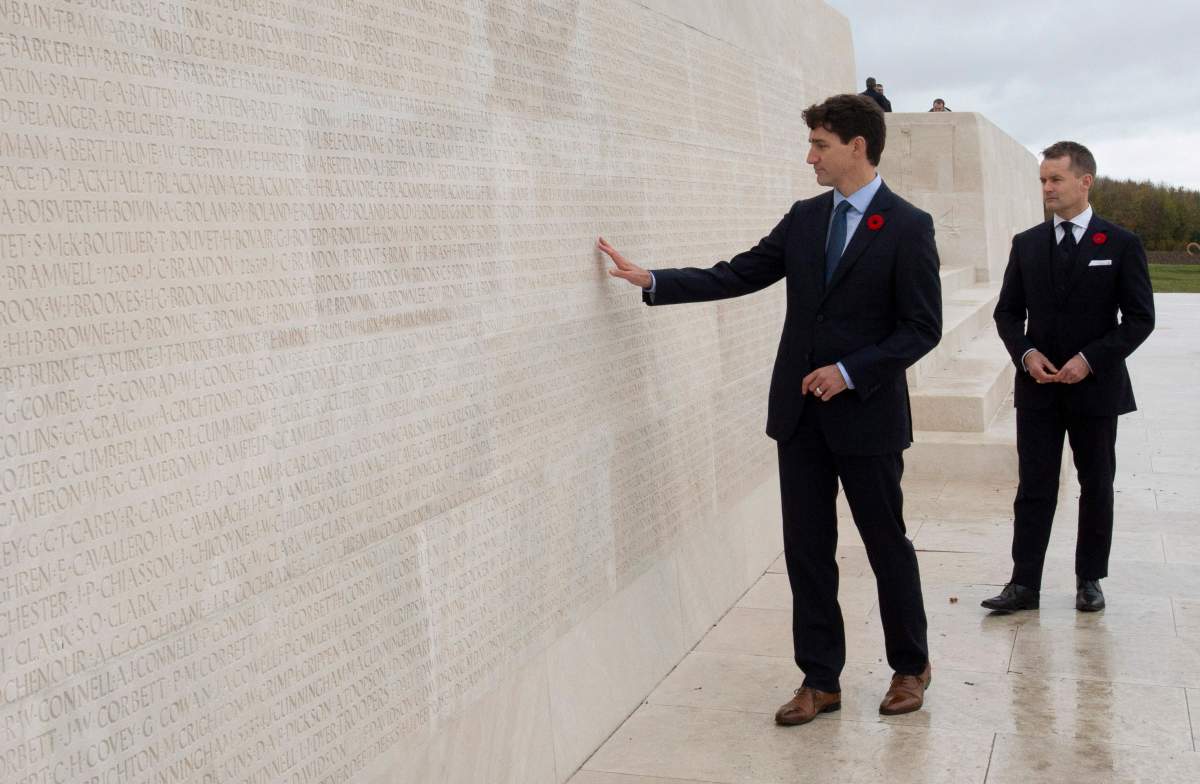The iconic monument at Vimy Ridge served Saturday as a reminder of Canadians’ wartime sacrifice, as Prime Minister Justin Trudeau made another visit to the memorial one day before the world marks 100 years since the end of the First World War.

Running his hands along the carved names of Canada’s war dead and walking among the graves – some with names, others simply marked as “a soldier of the great war” – Trudeau and his veterans affairs minister shook hands with veterans and thanked them for their service.

The monument has become the symbol of Canada’s experience during the “War to End All Wars,” during which approximately 650,000 Canadians and Newfoundlanders served – a number considered remarkable given the population of the country was roughly eight million.
The prime minister visited Vimy Ridge last year to mark the centenary of the battle.
On Sunday, more than 60 world leaders are scheduled to gather in Paris to mark the 100th anniversary of the end of the First World War, making Trudeau’s stop at Vimy politically symbolic.
WATCH: Trudeau pays respects to fallen soldiers in France

Roland Paris, a former foreign affairs adviser to Trudeau, says the combination of events this weekend gives the prime minister symbols to put behind his repeated public push for governments to not tear down international alliances.
Sunday will see Trudeau and other leaders stand alongside French President Emmanuel Macron at Armistice Day commemorations in Paris. Later on in the day, Macron will host a peace forum the French government hopes to make an annual draw for civil society and political leaders.
“Going to Vimy and the Armistice Day celebration…provides the opportunity for the prime minister to underscore why it was that Canadians have sacrificed in the past and the importance of maintaining the rules-based international order,” Paris said.

Get daily National news
WATCH: Promise to fallen comrade takes Ottawa councillor-elect to Windsor for Remembrance Day

Some 66,000 Canadian soldiers died during the First World War, between 1914 and 1918, and a further 172,000 were wounded. Those buried at Vimy and elsewhere believed defending Canadian values “were worth that sacrifice,” said Veterans Affairs Minister Seamus O’Regan.
“We must remember the lesson of these conflicts: that freedom is not free. That it is not easy. Indeed it is hard fought,” O’Regan said.
“But to remember those lessons is to remember those who fought these battles and who fight them still.”
WATCH: Historic Mons Bugle to be used in Edmonton Remembrance Day ceremonies

A lesson world leaders have learned from the First World War is how a regional dispute can spiral into a broader, global conflict, said Matthew Barrett, an expert on Canadian military history from Queen’s University in Kingston, Ont.
That concern about becoming entangled in a conflict feeds into U.S. President Donald Trump’s unease with military alliances such as NATO – which in turn keeps Trudeau talking about maintaining alliances.
Some 11,000 names of Canadians who died in France are inscribed on the Vimy monument, marking the ridge Canadian soldiers took from the Germans in April 1917.
WATCH: Bob Layton editorial: Lest We Forget

Fighting continued in Europe for a year afterwards before the armistice on Nov. 11, 1918.
“Canadians remember who you are, what you stand for and the history you defined, a history for which you bled and fought, a history built on your sacrifice. Thank you,” Trudeau told a group of veterans during remarks at one of the cemeteries where Canadians are buried.
Clouds hung over the site – rain holding off until the service at the monument had come to a close – and a cold, wet wind swept through the area, ever so slightly rustling the leaves of a sapling, grown in Canada and descended from oaks that once grew here.
In the aftermath of the Vimy battle, a Canadian soldier, Lt. Leslie Miller, plucked a handful of acorns from a downed oak tree and sent them back home to Toronto where they grew.
A group of volunteers have worked to get 100 saplings for the four-acre park to coincide with the centenary of the end of the First World War. The trees will grow inside four concentric rings, each one representing one of the four Canadian divisions that fought at Vimy.
Trudeau and O’Regan walked the newly opened memorial park.
Trudeau now travels to Paris where he is scheduled tonight to attend a dinner hosted by Macron.















Comments